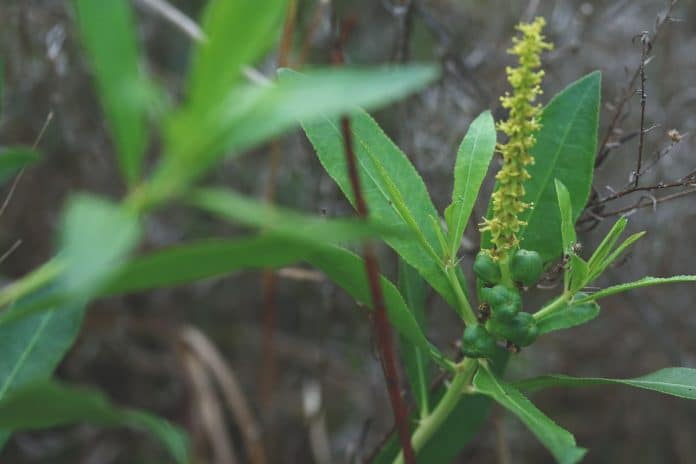For our fourth section of wildflowers blooming in Hernando County, we take you to those wildflowers that thrive in sandy soils. Areas like the longleaf pine and sandhill habitats are perfect locales for these flowering plants. Just in time to show off their beautiful colors and provide an abundance of nectar for bees, butterflies and other pollinators.
Queen’s Delight
Stillingia sylvatica probably brought delight to a medieval queen due to its medicinal value and not so much because it is stunning to behold. This unappreciated Florida native is rather on the plain side. It has inconspicuous male and female flowers on the same plant, but they bloom at different times to assure diversity in pollination. They are in the euphorbiaceae family, which are commonly referred to as spurges. Its dark green, shiny leaves can grow out to be 12 – 18 inches across. It is a common understory wildflower found in sandhills, old fields and open woodlands throughout the Southern Coastal Plain, and as far west as Texas, and as far north as Colorado. This succulent is tenacious and drought tolerant. It brings delight to pollinators, but more so to the rabbits and whitetail deer that nibble on its broad leaves.
Pale Meadowbeauty
The Rhexia mariana’s hypanthium, or the cup-like structure that is the base for the petals, sepals, and stamens, is long and urn-shaped, giving this blooming beauty it’s distinct form. There are only a few counties in Florida where they haven’t been reported. They grow to be about 2 feet tall and like sunny to partially sunny areas. They prefer moist, acidic sandy or loam soils. They are difficult to propagate, but if you have a wet area, they might just find their way there and sucker and spread without taking over.
Purple Passion Flower
Passiflora incarnata is definitely the flashy diva of our wildflower world. Its large, Suessian-like flowers are intricately fascinating. Being a native vine, it’s aggressive tendencies are affectionately labeled “pioneering.” It certainly can try to take over your garden, but it is not an ecological nuisance like an invasive exotic plant. It has been known to take over disturbed open areas, such as sandy pastures. It can easily be trained to climb a trellis, but I must warn you to provide a sturdy one! This is a host plant for the Gulf fritillary as well as our state butterfly, the Zebra longwing. You will thoroughly enjoy this zealous butterfly attractor in the warm months, and it may even produce some passion fruit! Don’t worry too much about its aggressive tendencies, because it will freeze back in the winter. Just cut away the dead parts when the danger of frost is over, and start all over again! Please be sure to utilize this native variety, as there are non-native passion vines that are considered invasive exotic plants.
Powerpuff
Mimosa strigillosa, also called Sunshine Mimosa, is one tough ground cover. It only gets to be 6-9 inches in height but can spread over a large area. It is in the family of “sensitive plants” because you can watch the leaves fold up if you touch them. But don’t let that make you think this plant is dainty. Pink powderpuff flowers, which seem to defy gravity by looking larger than the stems should be able to accommodate, pop up in abundance in this ground cover in the spring and summer. The pretty pink stamens have little yellow bits of pollen on the tips, creating an almost sparkly effect. This fast spreader can take some maintenance to control in a small bed (it will want to spread further), but will look great. Or you can use it for your entire lawn, as a friend of mine does. It handles walking and occasional mowing just fine and will attract a host of pollinators, which can’t be said of your standard turfgrass lawn.
FEATURE: Butterfly Milkweed/ Sandhill Milkweed
Asclepias humistrata is unique in the milkweed family, in that it has broad, low growing, deeply veined leaves. The plant could win a beauty contest with its leaves alone. But of course, we all love milkweed for its umbel flower arrangements. This particular native milkweed has white flowers, with a touch of a pink hue. The veins in the leaves are lavender colored, and age into a darker purple. Of course, all milkweeds are the only host plants for the monarch butterfly, which is why they have garnered so much attention lately. Native milkweeds are the best to make available for our monarchs, for many reasons. The main reason is that the natives follow a season, and will die back in the winter. The tropical milkweed, or asclepias curassavica, does not die back in the winter and that encourages the monarchs to stay here, where they can succumb to a freeze, or hatch out with no other flowers to nectar on. If you have tropical milkweed, please keep it cut back from November until the danger of freezes are over, so the monarchs move on to more tropical and safer regions. Sandhill milkweed is difficult to find for sale, even in native plant nurseries. It has a very long taproot, making propagation very difficult. There are other native milkweeds available among native plant dealers, so try to pick some up when they have stock available. All milkweed will respond poorly to a heavily watered, mulched garden with rich soil. They thrive on sandy soil with the freedom to grow wild and do their own thing.

